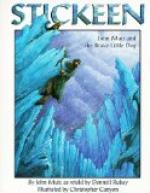Retracing my devious path in imagination as if it were drawn on a chart, I saw that I was recrossing the glacier a mile or two farther up stream than the course pursued in the morning, and that I was now entangled in a section I had not before seen. Should I risk this dangerous jump, or try to regain the woods on the west shore, make a fire, and have only hunger to endure while waiting for a new day? I had already crossed so broad a stretch of dangerous ice that I saw it would be difficult to get back to the woods through the storm, before dark, and the attempt would most likely result in a dismal night-dance on the glacier; while just beyond the present barrier the surface seemed more promising, and the east shore was now perhaps about as near as the west. I was therefore eager to go on. But this wide jump was a dreadful obstacle.
At length, because of the dangers already behind me, I determined to venture against those that might be ahead, jumped and landed well, but with so little to spare that I more than ever dreaded being compelled to take that jump back from the lower side. Stickeen followed, making nothing of it, and we ran eagerly forward, hoping we were leaving all our troubles behind. But within the distance of a few hundred yards we were stopped by the widest crevasse yet encountered. Of course I made haste to explore it, hoping all might yet be remedied by finding a bridge or a way around either end. About three-fourths of a mile upstream I found that it united with the one we had just crossed, as I feared it would. Then, tracing it down, I found it joined the same crevasse at the lower end also, maintaining throughout its whole course a width of forty to fifty feet. Thus to my dismay I discovered that we were on a narrow island about two miles long, with two barely possible ways of escape: one back by the way we came, the other ahead by an almost inaccessible sliver-bridge that crossed the great crevasse from near the middle of it!
After this nerve-trying discovery I ran back to the sliver-bridge and cautiously examined it. Crevasses, caused by strains from variations in the rate of motion of different parts of the glacier and convexities in the channel, are mere cracks when they first open, so narrow as hardly to admit the blade of a pocket-knife, and gradually widen according to the extent of the strain and the depth of the glacier. Now some of these cracks are interrupted, like the cracks in wood, and in opening, the strip of ice between overlapping ends is dragged out, and may maintain a continuous connection between the sides, just as the two sides of a slivered crack in wood that is being split are connected. Some crevasses remain open for months or even years, and by the melting of their sides continue to increase in width long after the opening strain has ceased; while the sliver-bridges, level on top at first and perfectly safe, are at length melted to thin, vertical, knife-edged blades, the upper portion




